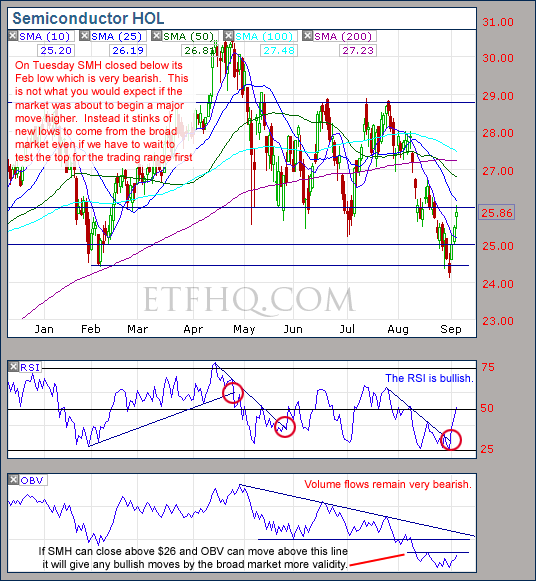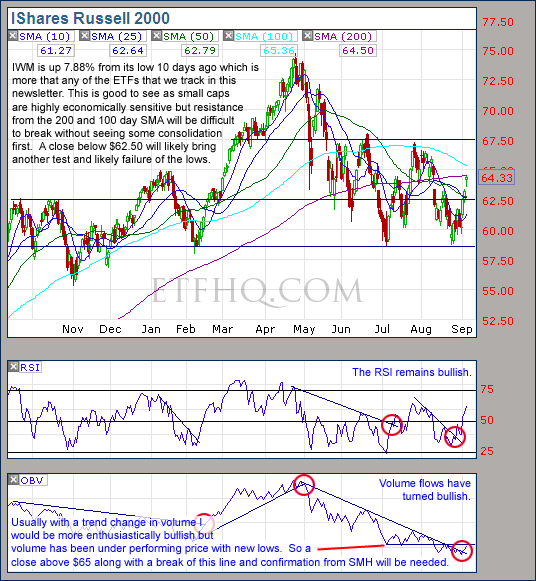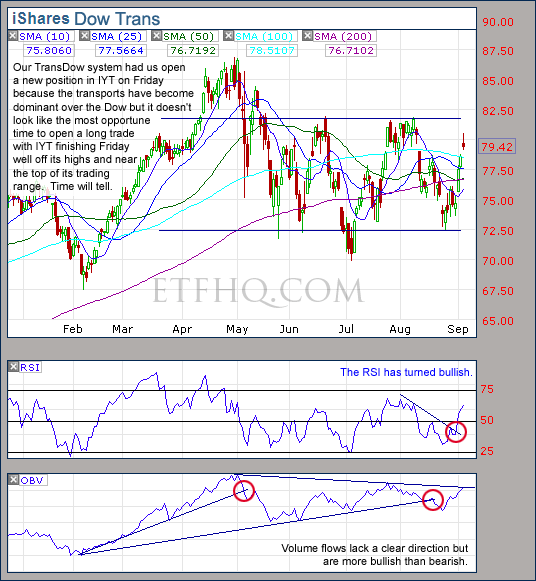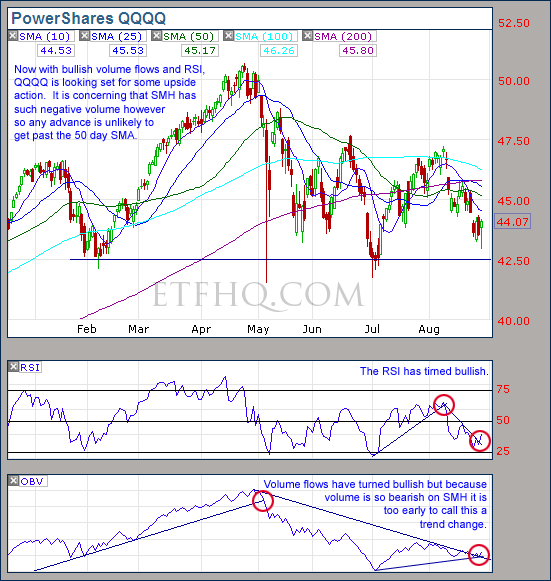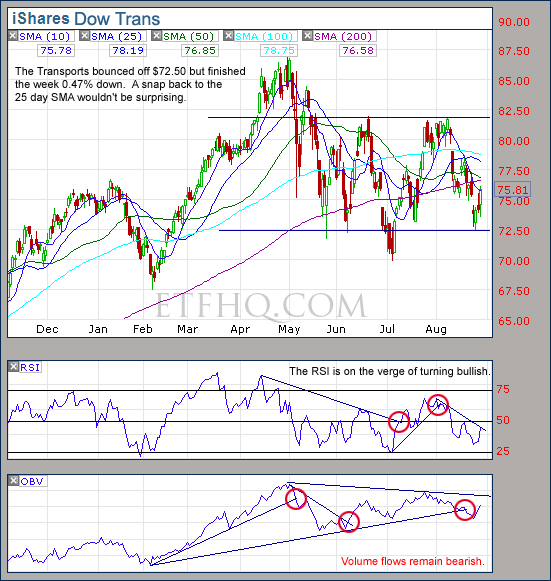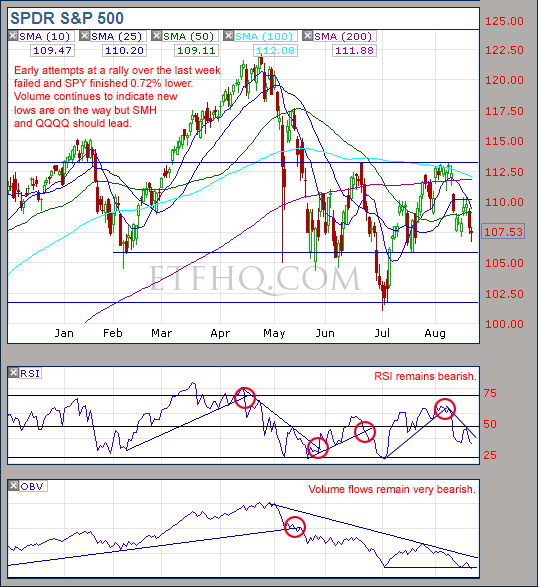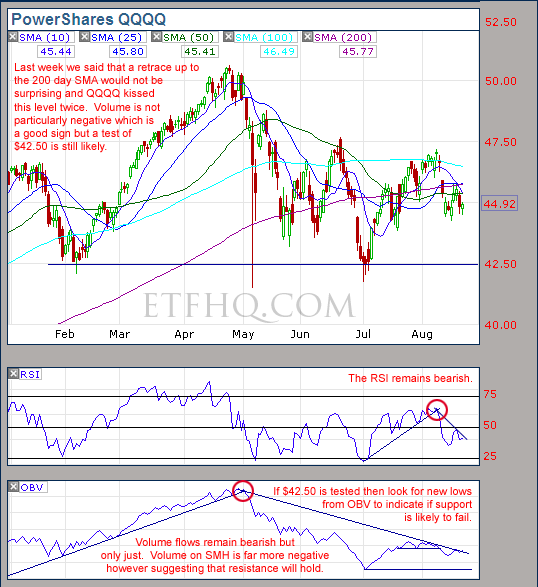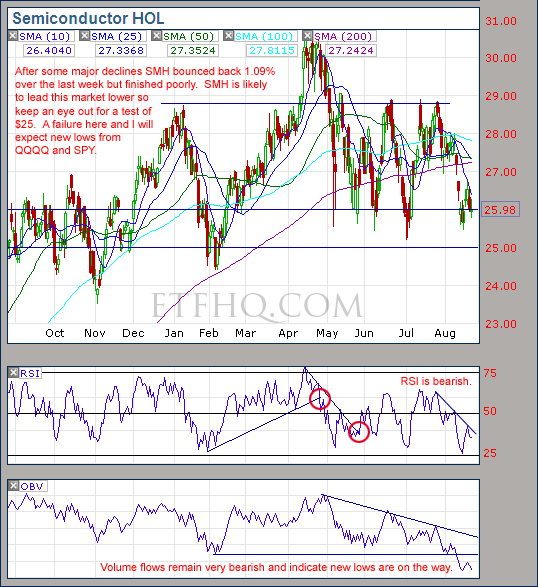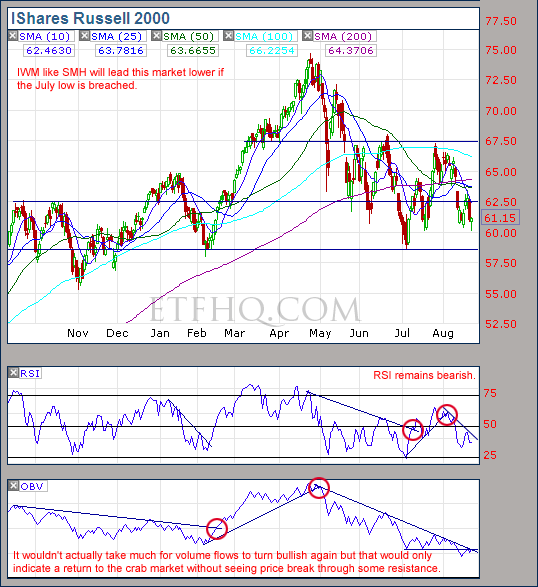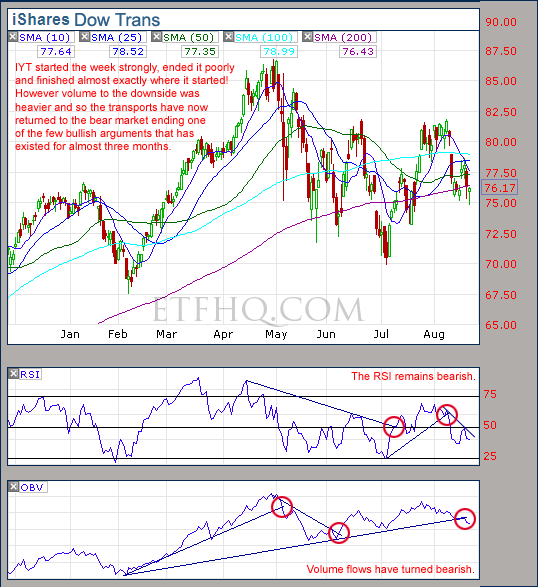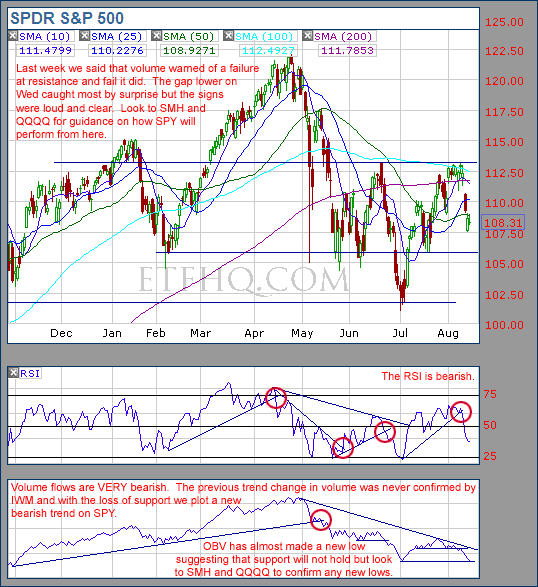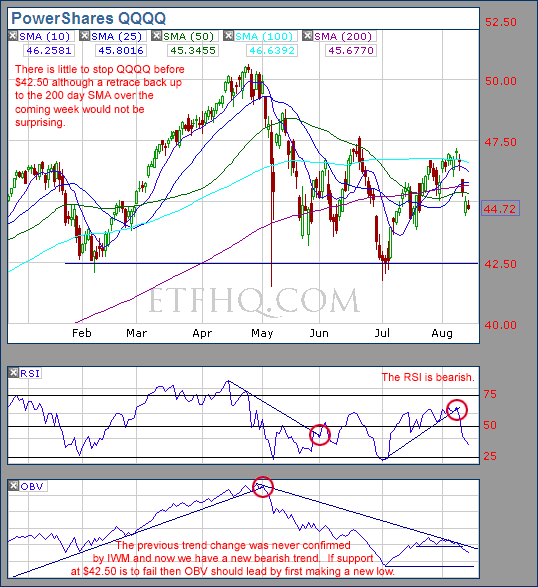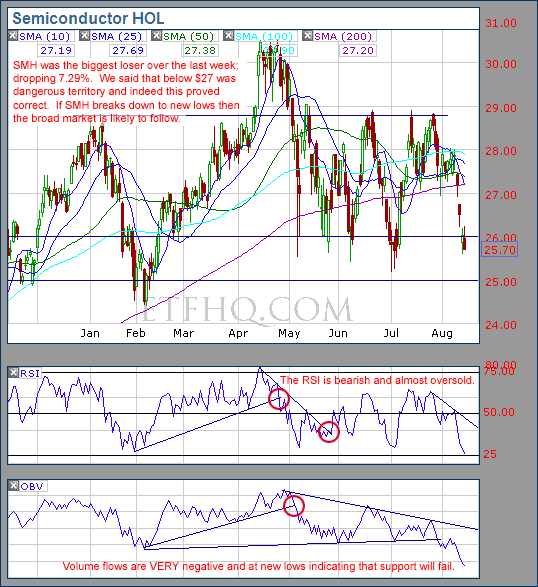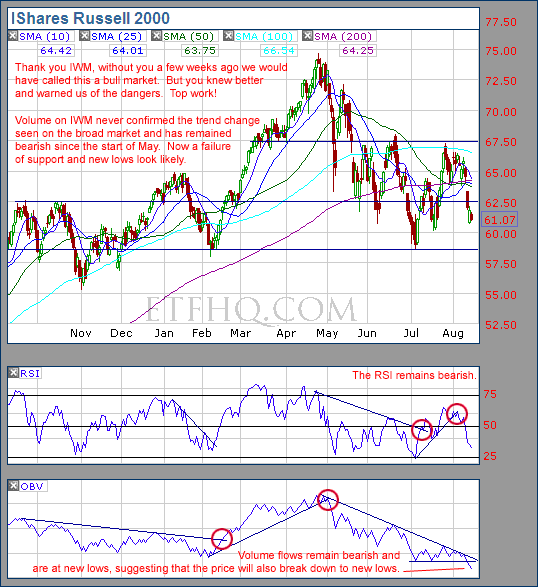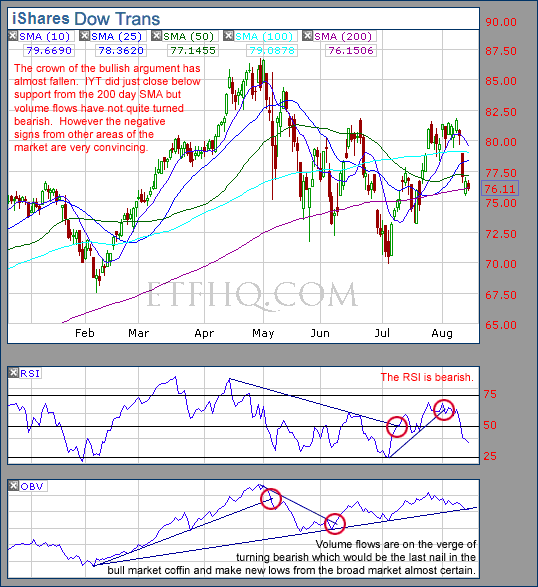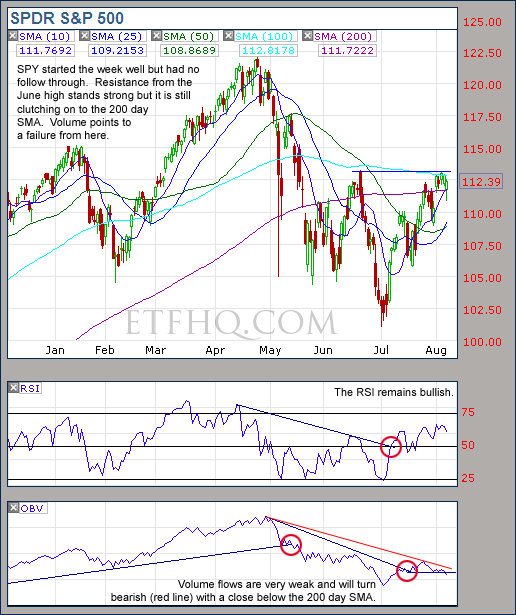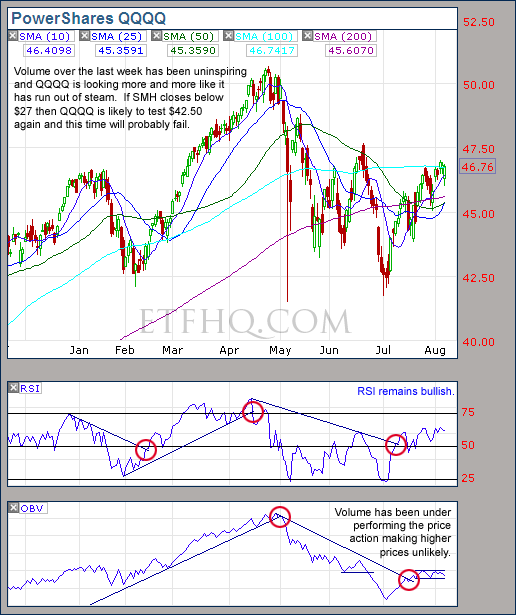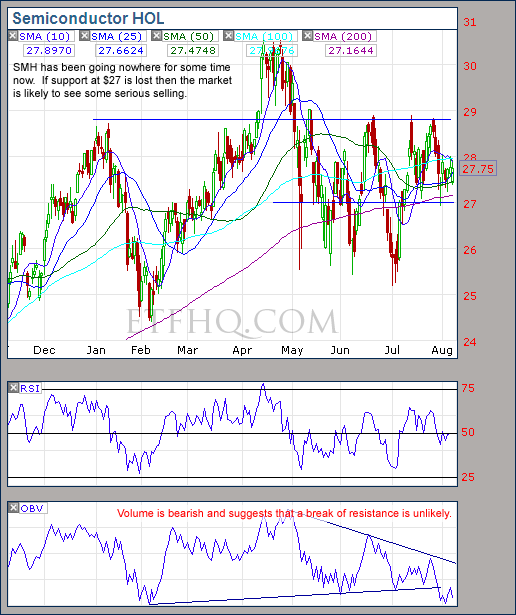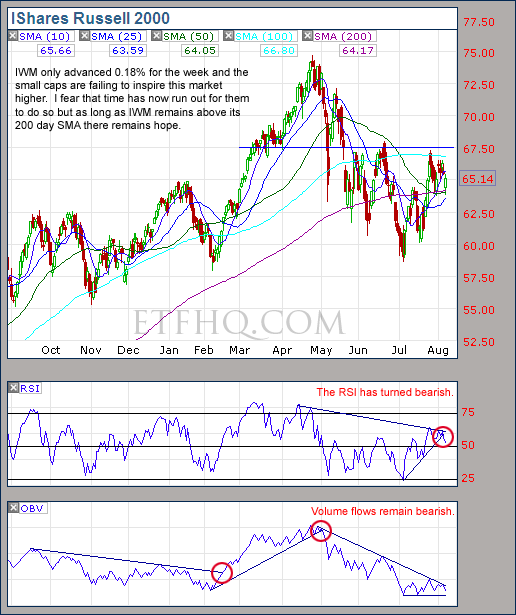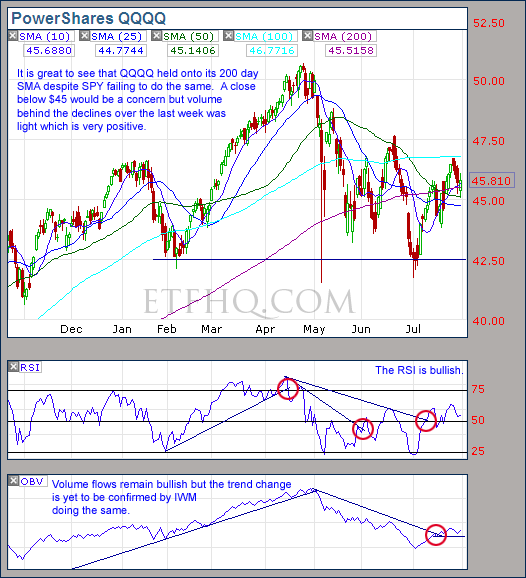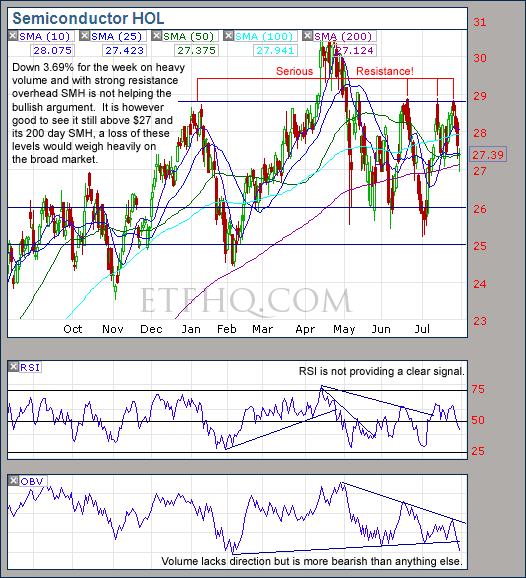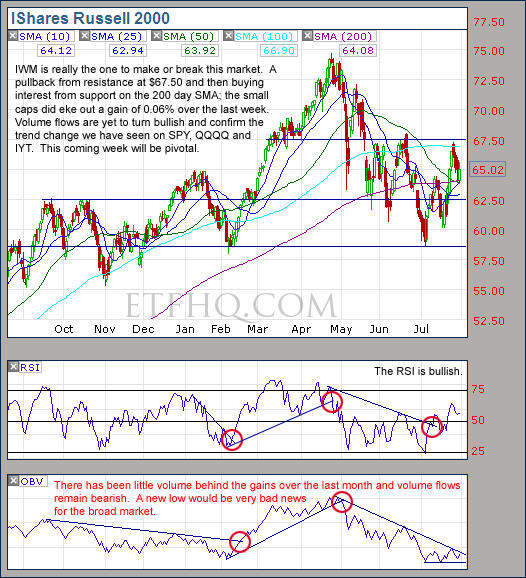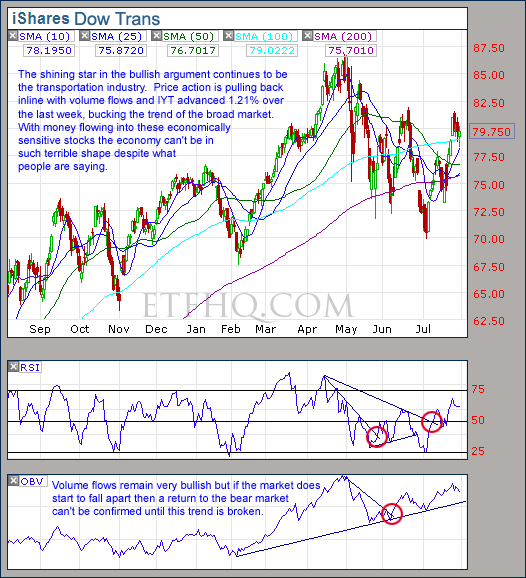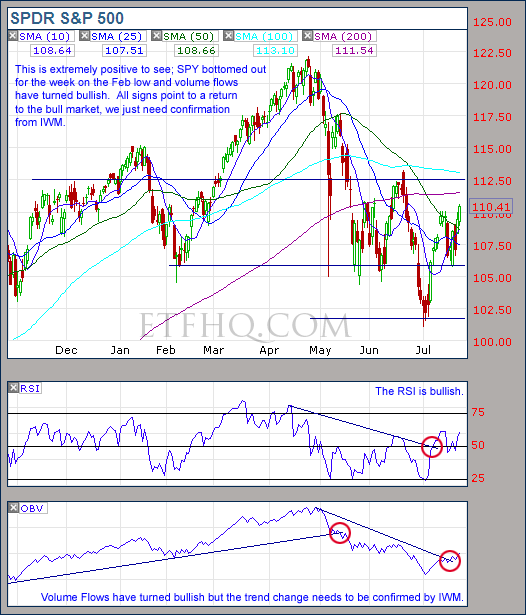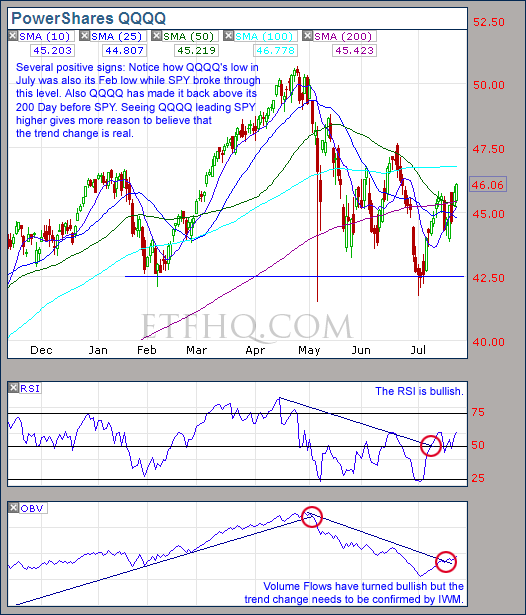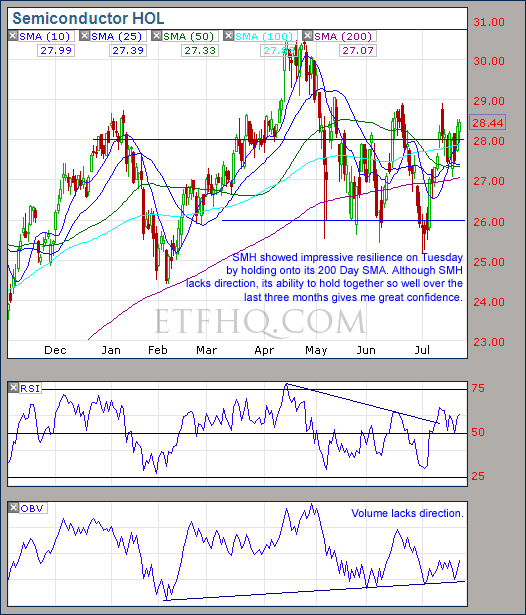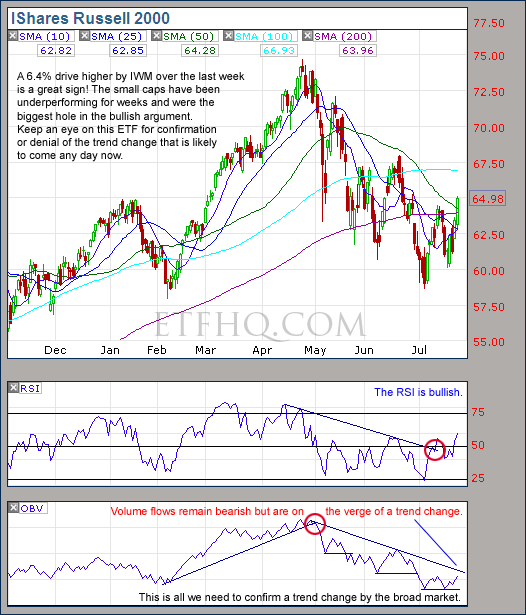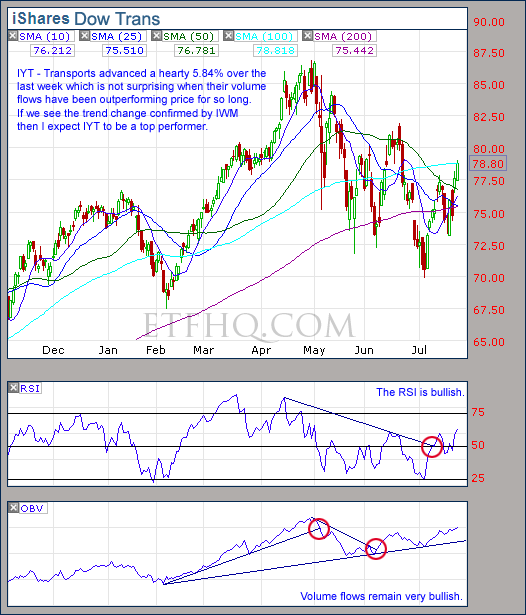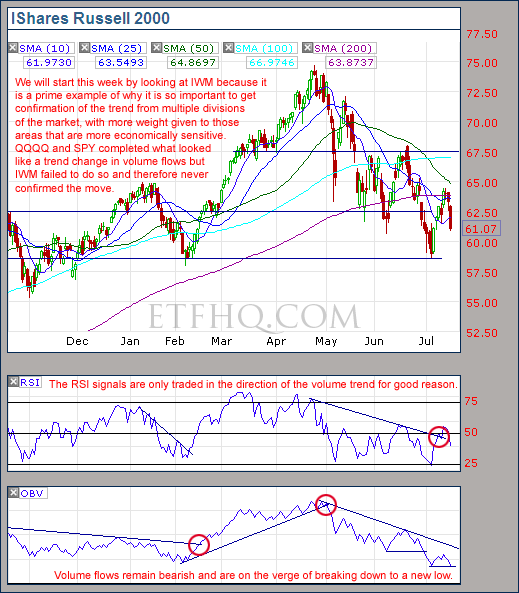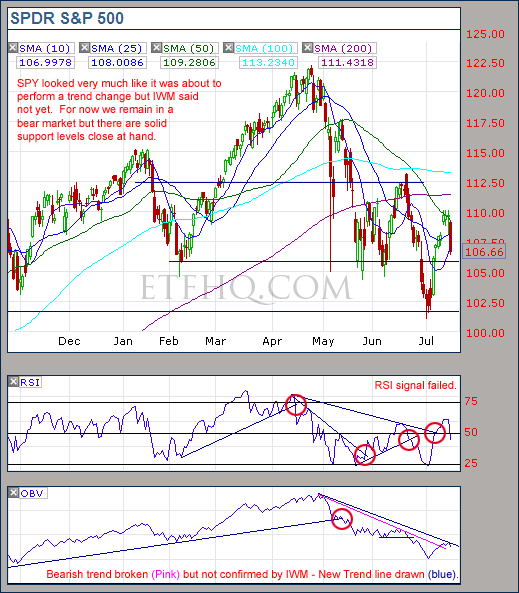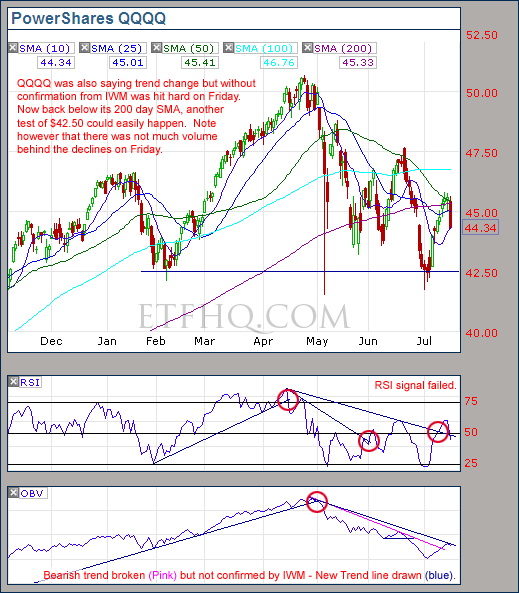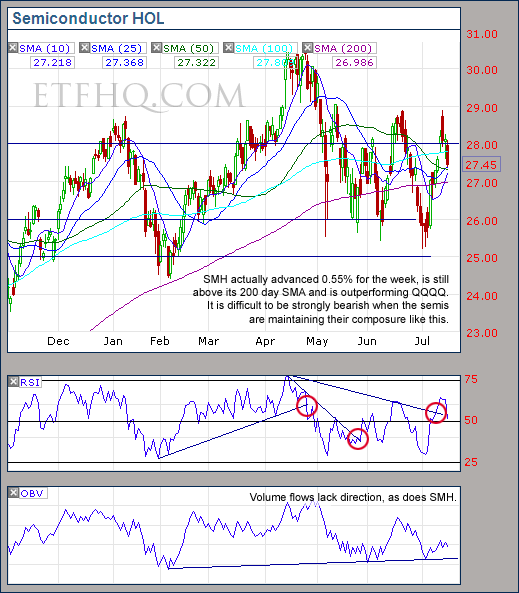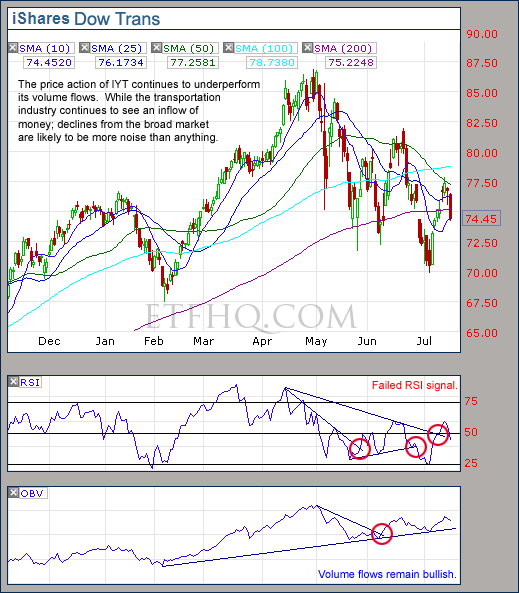September 13, 2010 – 01:35 am EDT
It is not often that you see a market that looks like more of a bull trap than this one. At first glance the major indices appear to be recovering nicely, on healthy volume and working their way through resistance. But…..
Where’s The Beef
.
This recent rally lacks substance and there are warning signs of almost imminent failure. Why? Lets take a closer look:
****Thanks to all those who referred people to this newsletter over the last week. The more readers we have the more services we can provide you.
.
ETF % Change Comparison
.

Over the last week, two of the most economically sensitive areas of the market; the Semiconductors (SMH) and the Small Caps (IWM) bucked the trend and declined 2.95% and 0.95% respectively. Furthermore, SMH was the first to peak 148 days ago, was late to bottom 10 days ago, is the furthest from its high and closets to its low.
Semiconductors lead the business cycle and constantly undergo periods of under and over supply based on the growth of the economy. All expansion in this age requires technological info-structure, semiconductors are the building block of that info-structure and have a very short shelf life. This is why it is so concerning to see SMH getting left behind in the recent rally.
Learn more – ETF % Change Comparison
.
![]()
.
A Look at the Charts
.
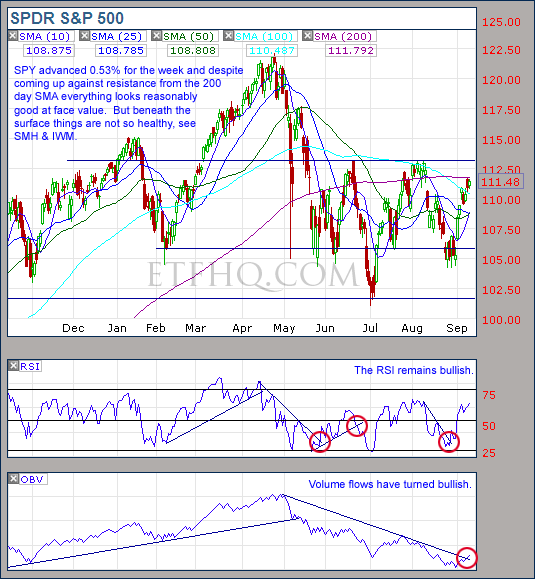
The trend change in volume from SPY looks great BUT means little while SMH and IWM continue to underperform.
.
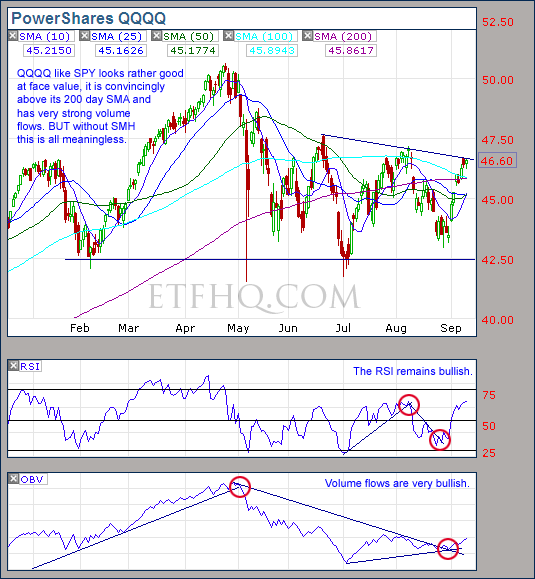
Great volume on QQQQ – yes, working its way through resistance – tick… But, without SMH to confirm, this is a hollow victory. If QQQQ closes back below its 200 day SMA then declines are likely to accelerate.
.

The challenges with SMH are clear; terrible volume flows, falling prices, near lows etc. Above $26 there is hope, below there is little.
.
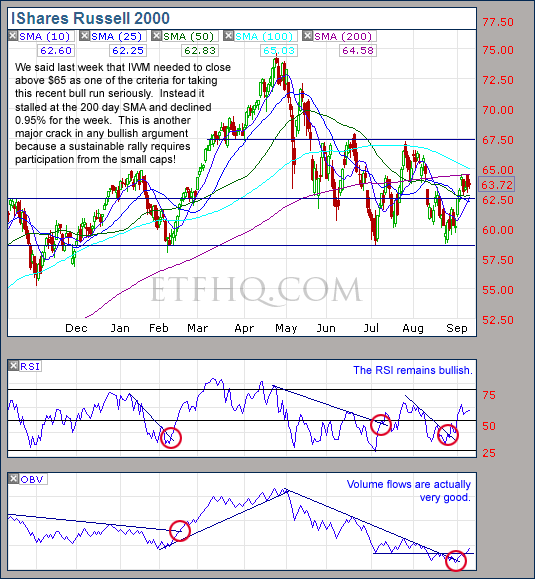
IWM actually has good volume flows which is very positive but the 200 Day SMA resistance is strong and a close above $65 is necessary before taking the bulls seriously. Below $62.50 we enter the danger zone.
.
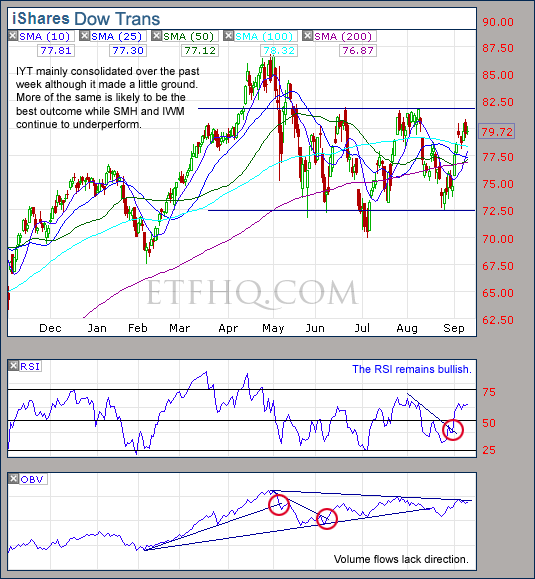
The transports are not offering much insight at the moment
.
![]()
.
OM3 Weekly Indicator
.

The OM3 indicator is on its second week of buy signals now but it’s concerning that SMH remains on a ‘Strong Sell’.
Learn more – The OM3 Indicator
.
![]()
TransDow & NasDow
.

The TransDow continues to indicate that the Transports are dominant over the Dow which is a positive sign and the position in IYT is basically flat at this point. The NasDow is showing no clearly dominant index between the Dow and the NASDAQ.
.
What the TransDow Readings tell us:
The TransDow measures dominance between the DJ Transportation Index (DJTI) and the Dow Jones Industrial Average (DJIA). In a strong market the more economically sensitive Transportation Index should be dominant over the DJIA.
Historically the DJTI has been dominant over the Dow 45% of the time. The annualized rate of return from the DJTI during this period was 18.47% with the biggest loss for one trade sitting at -13.27%. The annualized return from the DJIA during the periods it was dominant over the DJTI was just 4.06% and the biggest loss for one trade was -16.13%. A 4% stop-loss is applied to all trades adjusting positions only at the end of the week.
What the NasDow Readings tell us:
The NasDow measures dominance between the NASDAQ and the DJIA. Using the same theory behind the Trans Dow; in a strong market the more economically sensitive NASDAQ should be dominant over the DJIA.
Historically the NASDAQ has been dominant over the DJIA 44% of the time. Taking only the trades when the NASDAQ is above its 40 week moving average the annualized rate of return was 25.47% with the biggest loss for one trade sitting at –8.59%. The annualized rate on the DJIA during the periods it was dominant over the NASDAQ is just 8.88% and the biggest loss for one trade was –12.28%. A 8% stop-loss is applied to all trades adjusting positions only at the end of the week.
.
![]()
.
LTMF 80 & Liquid Q
.

Both LTMF 80 and Liquid Q remain in cash.
.
Historical Stats:
.

.
How The LTMF 80 Works
LTMF stands for Long Term Market Forecaster. It reads volume flows relative to price action and looks for out performance of volume measured on a percentage basis over the prior 12 months. During a sustained rally the readings will reach high levels (near 100%) making it imposable for the volume reading to always outperform price so any reading above 80% will maintain the buy signal. This system has outperformed the market over the last 10 years but performance has been damaged by some nasty losses. It only produces buy signals and only for QQQQ.
How Liquid Q Works
Liquid Q completely ignores price action and instead measures the relative flow of money between a selection of economically sensitive and comparatively stable ares of the market. It looks for times when the smart money is confident and and can be seen by through volume investing heavily is more risky areas due to an expectation of expansion. This system has outperformed the market over the last 10 years and remained in cash through most of the major declines. It only produces buy signals and only for QQQQ. We will provide more performance details on the web site for these systems soon.
.
![]()
.
Summary
What were subtle warnings that the market was soon to fail are now quite blatant. No lasting gains can occur while IWM and SMH continue to underperform the broad market and if QQQQ closes back below its 200 day SMA along with IWM below $62.50 then the declines to follow could be quite sharp.
However we must always be open to the possibility that we are wrong so if SMH can close above $26 and IWM above $65 then the situation will need to be reassessed. Please exercise extreme caution at the moment as new lows are highly probable in the near future.
On a side note here is a fantastic – Visual Guide To Deflation – Enjoy.
.
Any disputes, questions, queries, comments or theories are most welcome in the comments section below.
.
Cheers
Derry
And the Team @ ETF HQ
“Equipping you to win on Wall St so that you can reach your financial goals.”
.
P.S Like ETFHQ on Facebook – HERE
.
![]()
.
Quote of the Day:
“America will never be destroyed from the outside. If we falter and lose our freedoms, it will be because we destroyed ourselves. – Abraham Lincoln



